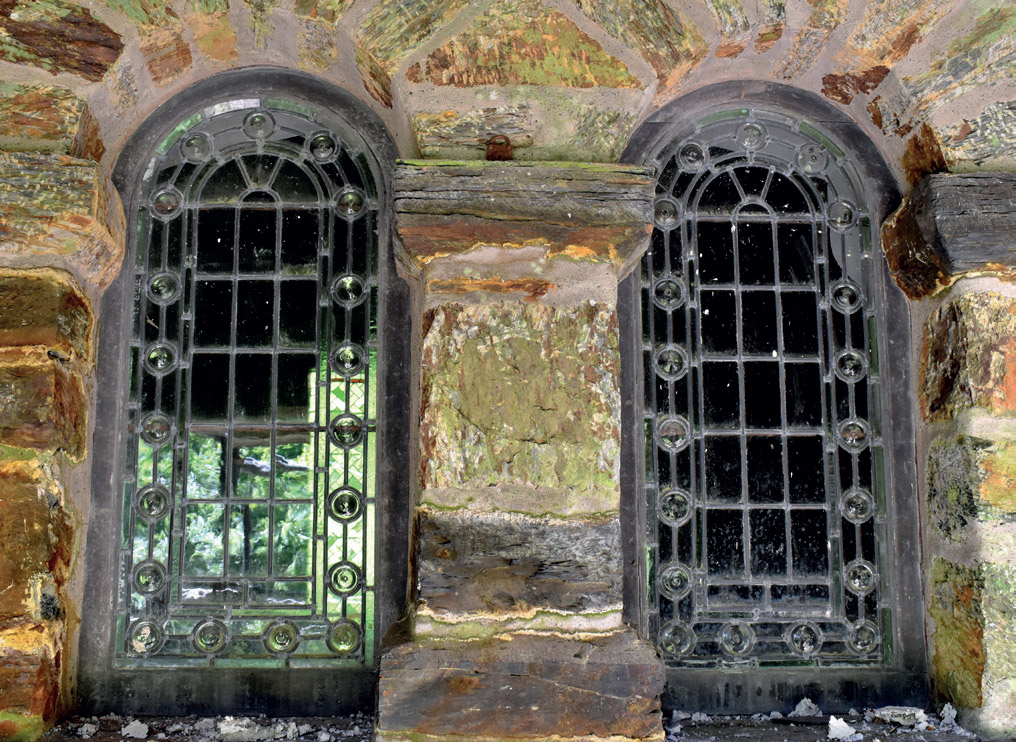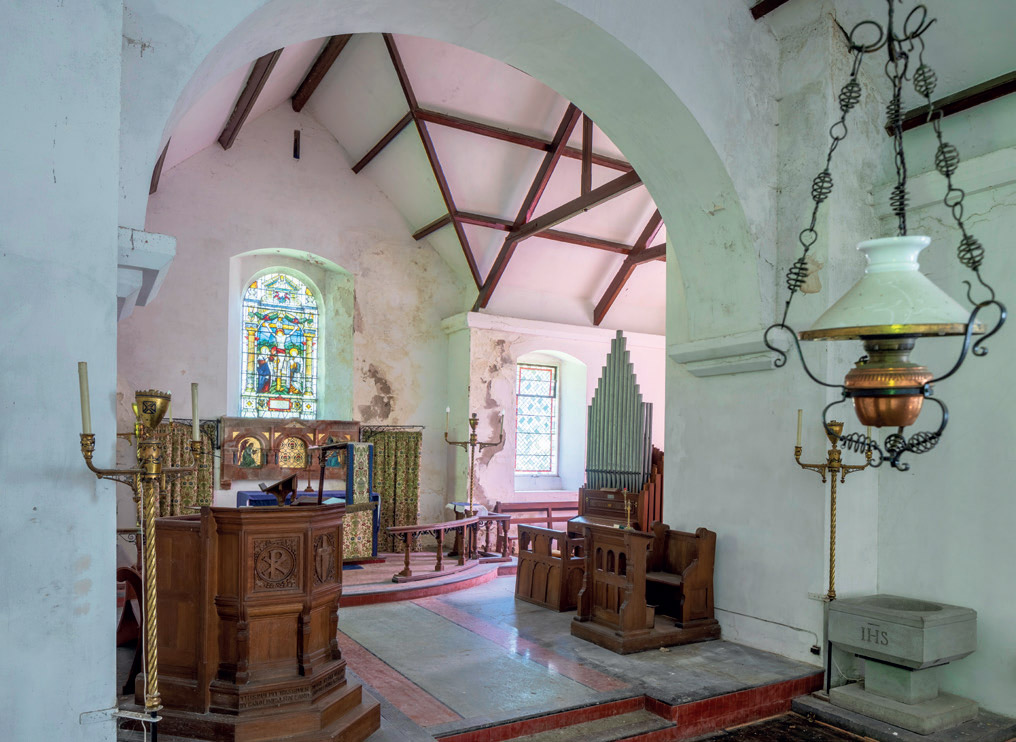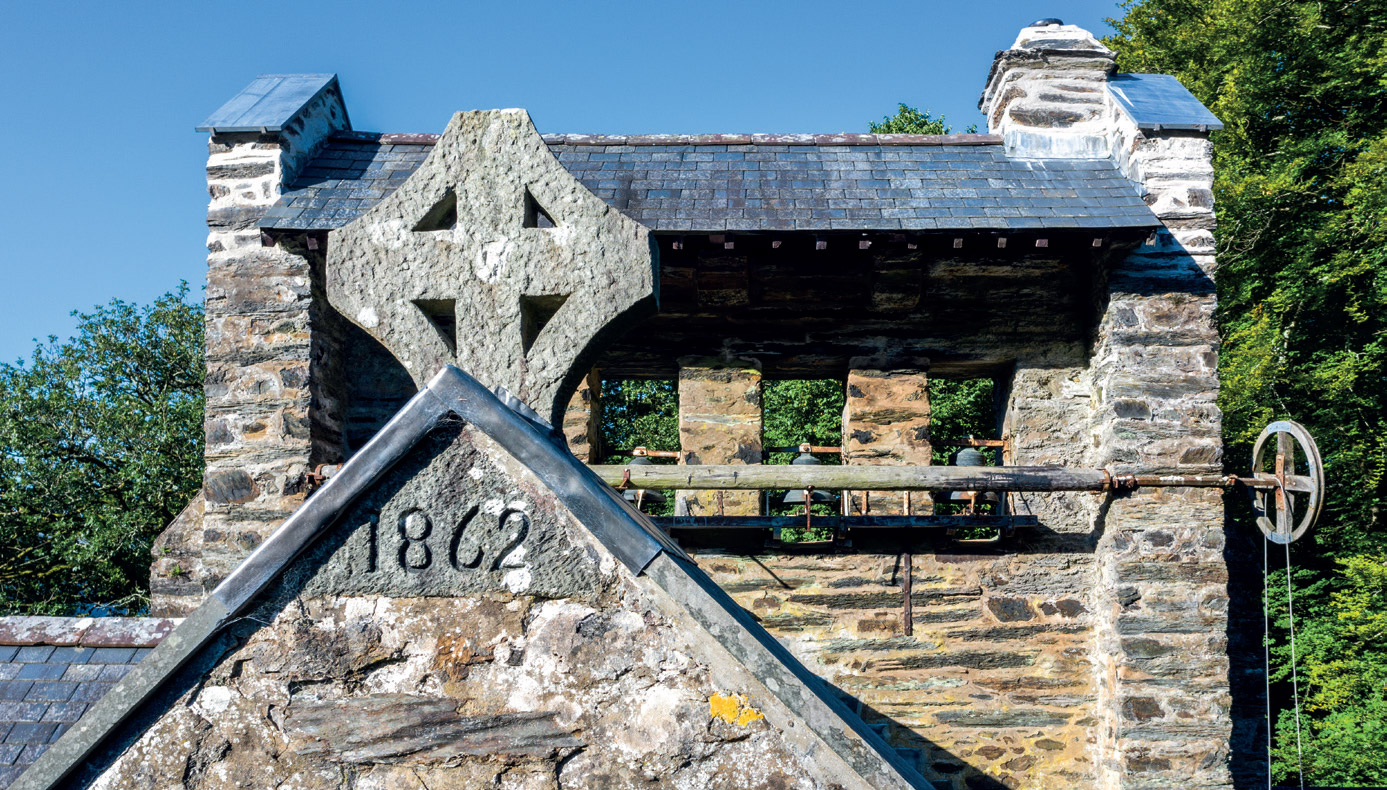St Philip’s Chapel, Caerdeon
Rachel Morley
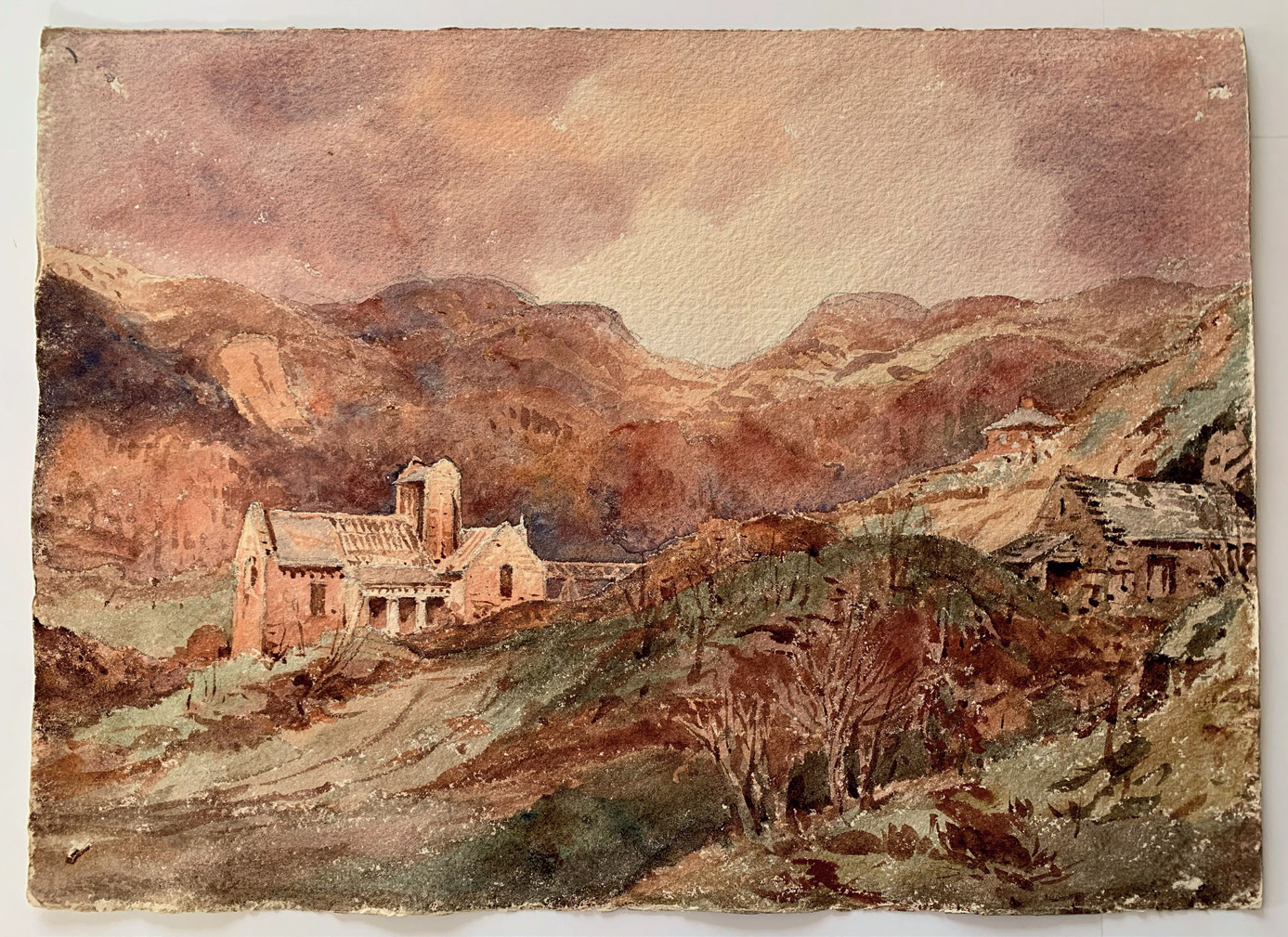
One of the Reverend John Louis Petit’s watercolours showing the construction of St Philips set against the romanticised landscape (Image courtesy of The Rev Petit Society)
HIDING IN the mountains between Barmouth and Bontddu is a church of extraordinary individuality and importance. St Philip’s Chapel, Caerdeon is hard to define. It has been described as rustic Mediterranean, Alpine, of French Basque influence or like an Italian farm building. In 1863 The Ecclesiologist wasn’t complimentary about it, describing it as ‘something between a large lodge gate and a lady’s rustic dairy’.
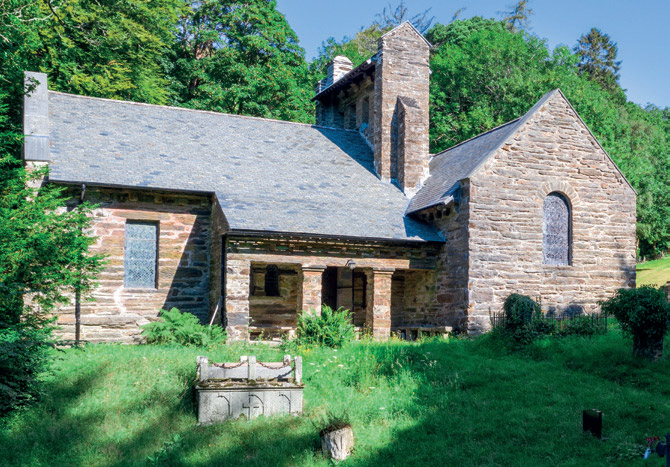 |
||
| The entrance and loggia today (Photo: Andy Marshall) |
Neither was The Ecclesiologist very complimentary about its architect, the Reverend John Louis Petit (1801–68), labelling him ‘a clever amateur’. The magazine’s disdain for Petit presumably stemmed from his openness to architectural ideas from a range of sources, all recorded in his book Remarks on Church Architecture (1841), which put him at odds with advocates of strict Gothic Revival principles.
While not a household name like his contemporary John Ruskin, Petit was one of the leading architectural writers of his age and one of the few who resisted the ‘copy Gothic’ that was so fashionable in the 19th century. From the 1840s when destructive restoration was at its peak, he was a pioneer in arguing for the preservation of ancient churches, and later proposed original, modern designs for churches.
In addition to architecture, Petit was an accomplished topographical watercolourist. He painted in a style foreshadowing Impressionism and exhibited his work widely in support of his architectural arguments. His work remained hidden for 150 years after his death, in the attic of a descendant. After his great-niece died, the entire hoard was dumped at auction during the 1980s and 1990s and his works are now widely dispersed in private collections, but fortunately The National Library of Wales holds the largest public collection of Petit’s artwork.
Petit painted St Philip’s throughout its construction, so we have an invaluable record of its building process. His artistic talents certainly contributed to the great success of St Philip’s: despite its continental influences, it is in harmony with its North Wales landscape. Petit achieved this through the use of local materials and building traditions. Even The Ecclesiologist had to admit that it has ‘picturesque appropriateness’.
The rusty, rubble-slate construction includes a lean-to loggia with stone benches and pairs of round-headed, Romanesque windows. A unique bellcotecum- chimney holds four bells that could be rung by a large wheel, found in a shelter on the north side of the church. For many years these were rung by Bill Tilman mountaineer and explorer, who scaled Mount Everest twice in the 1930s.
Inside, St Philip’s is quite simple. The walls are white-washed and bare. The pews are contemporary with the construction and are plain and not fixed. Decoration is saved for the sanctuary, which has a Byzantine feel, with mosaics and marbles. The east window, a Crucifixion by Kempe, was inserted in 1892.
St Philip’s is Petit’s only surviving building. It is utterly unique. In 2018, four years after it had closed, with its future hanging in the balance, Cadw reassessed the church and upgraded its status to Grade I. One of the reasons given was that the building’s ‘special architectural interest as a highly unusual and distinctive church for its period, boldly original in its style and relationship with its landscape… It gives clear expression to [the architect’s] views, which provided a counterweight to the prevailing orthodoxies of the Gothic Revival.”
Another justification was that “the building is also of historic interest for its controversial role in Welsh ecclesiastical history”. This was because in the 1860s St Philip’s rocked the Anglican church. The Bishop of Bangor issued a licence stating that, as the church was a private chapel for The Reverend WE Jelf, Censor of Christ College, Oxford, services and sermons should be delivered only in the English language. This was challenged by the Rector of Llanaber in whose parish it lay, as there was a legal obligation to hold services in Welsh in Welsh speaking areas. The rector brought Jelf before the Court of Arches and was successful, but the situation worsened when the Bishop of Bangor introduced a bill into the House of Lords to enable services to be conducted in English in Welsh speaking areas, provided certain conditions were met. This became the English Services in Wales Act of 1863, passed as a direct result of the building of this church.
VISITORS ENTER AT THEIR OWN RISK
As a Grade I listed building, St Philip’s is of exceptional importance. Just 1.6 per cent of all listed buildings in Wales are Grade I. Yet, taped to the south door the notice that welcomes people to St Philip’s these days states that they enter at their own risk. And visitors have good reason to be cautious. Chunks of plaster are dropping from the ceiling and the ancient electrics are dangerous.
The church was built on a natural promontory with the land falling away, quite dramatically, to the north, south, and west. It’s likely that the site infilled to create a level base for building and, as a result, the church is moving – and cracking. The complicated drainage system has added to the problems and water has flooded in through the cracks, soaking the fabric. This in turn is causing the decay and localised collapse of lath and plaster ceilings in the nave and sanctuary, and in the loggia too.
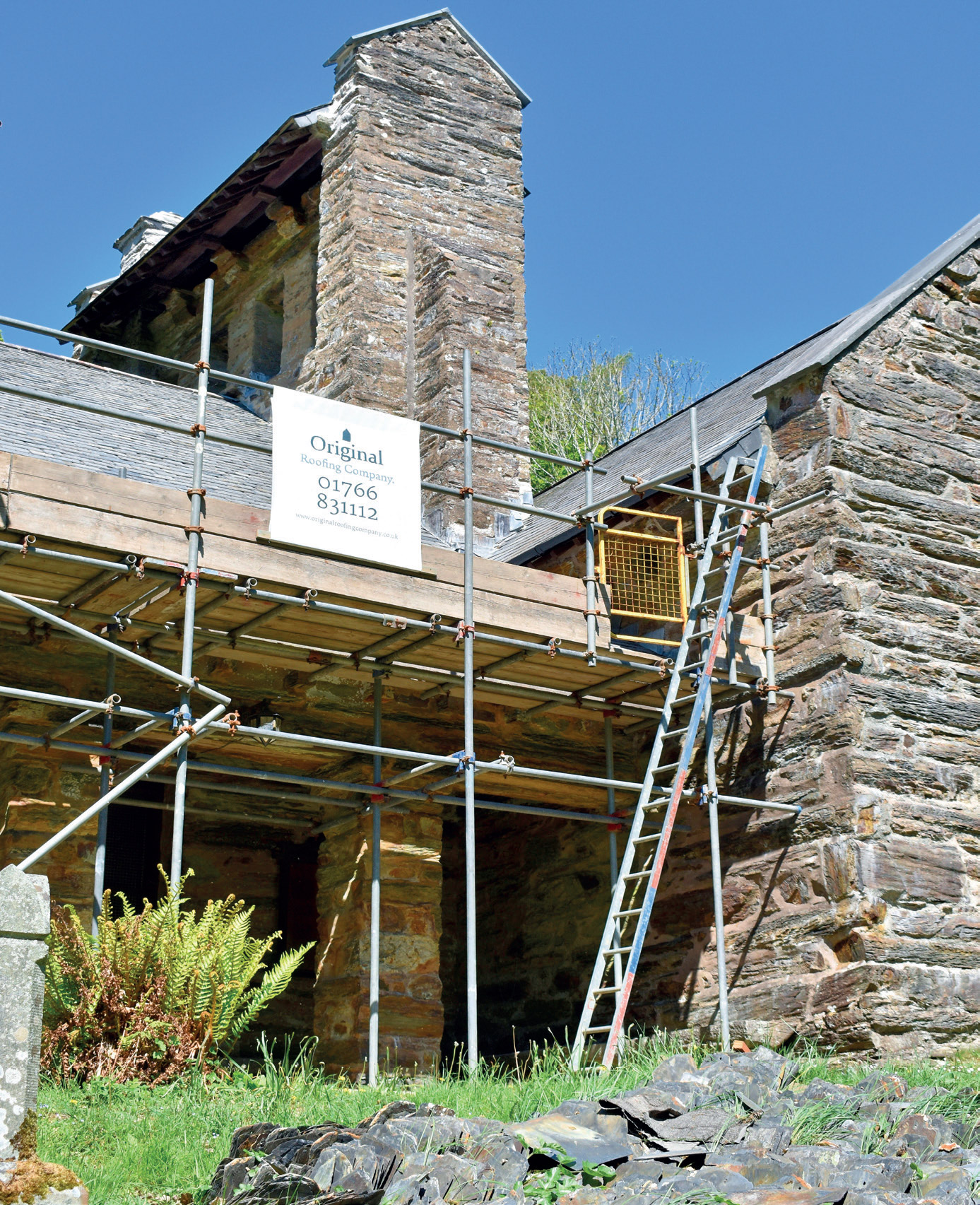 |
||
| Reslating the nave and loggia – ferrous inclusions on the original slates prevented many of them from being reused in the foreground |
Because of the clogged and collapsing drains the walls are crumbling at low level. The roofs, neglected for many years, are now thick with vegetation and include some well-established trees.
For a building of such architectural and historical importance, you might wonder how it slipped into such decline. However, getting to or even finding St Philip’s is not easy: it is closely surrounded by trees and tucked up a narrow, steep, winding slip road. The church was built to serve the students and guests of Rev Jelf who lived at Plas Caerdeon, but this country house is now an outdoor education centre owned by Liverpool Hope University, and the church itself still has just a scattering of houses around it.
By 2014, the number of regular worshippers had dwindled to nothing, and the church closed. It sat for four years awaiting its fate. However, over these years, it had not been alone: the Friends of Friendless Churches (FoFC) and The Rev Petit Society have been its steadfast champions, willing it to survive. Finally, in late 2018 Cadw and the Representative Body of the Church in Wales (the property department) agreed that St Philip’s, with its newly acknowledged status, should be vested in the care of FoFC. Nevertheless, legal machinations meant that the church had to wait another year for its acquisition to be completed.
In late 2019, adamant that this important building should not sit through another winter, FoFC began work on making St Philip’s watertight. The budget was tight, so works had to be prioritised carefully. In this first phase, following careful assessment, it was decided that all roof slopes had to be stripped and re-covered. This was the first time in its 156 years that the church had been re-roofed. And while the ecology survey confirmed the roof did not home any bats, it did not detect that squirrels had gnawed the rafters to pencil thinness in some places, nor that a colony of more than 30,000 bees were residing in the roof void. (Readers may be pleased to learn that the bees were carefully collected and rehomed several miles away, and are now happily producing honey, a jar of which sits in the author’s own kitchen cupboard.)
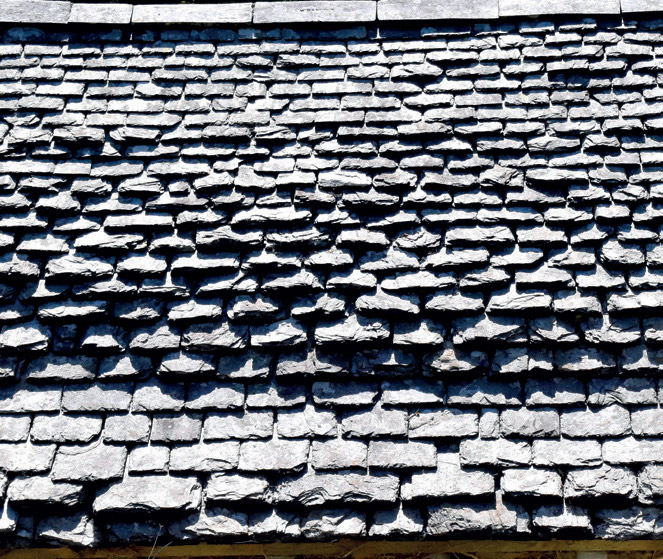 |
||
| Original slates on the roof of the lychgate |
All roof slopes were stripped, the timbers repaired and where needed, replaced, and the lead flashings were renewed. It had been anticipated that there would be a high yield of salvage in the existing roof slates, but once on site many of the slates were found to have large ferrous inclusions, which creates a weakness. This meant that a higher proportion of new slates had to be introduced than had been allowed for in the budget.
Rainwater goods at St Philip’s were labyrinthine, with swan-necks galore. These, coupled with years without maintenance, resulted in a lot of damage. Rationalising the rainwater goods made the disposal system work more efficiently and effectively.
The joints of the rubble-slate walls had at one time been buttered over with a thick cementitious mortar. This was causing localised decay of the stonework and significant internal damp. While the scaffold was in place, it was prudent to rake out the cement and repoint in lime mortar.
St Philip’s is now watertight but more work is needed. A drainage survey is required and repairs and improvements to the system need to be planned. The cracking needs to be monitored and the ancient electrical installation needs to be overhauled. Then there are the repairs that are required to the lath and plaster ceilings, the interior wall surfaces and the glazing, as well as the extensive redecorating. And a considerable amount must be raised to fund this work. This is just the beginning…
THE FRIENDS OF FRIENDLESS CHURCHES
FoFC is a tiny charity which was set up in 1957 to save disused but beautiful places of worship of architectural and historical interest from demolition, decay and unsympathetic conversion. There are now 54 churches in its care: 28 in Wales and 26 in England, and the charity has helped countless more. We believe that ‘an ancient and beautiful church fulfils its primary function merely by existing’.
The charity was founded by Ivor Bulmer-Thomas from Cwmbran after a very public row with the Archbishop of Canterbury. Ivor pointed out that the process for closing a church focussed only on the pastoral side of things, and never acknowledged that a church may be of architectural, artistic, historic or cultural importance.
Eleven years of lobbying ensued before formal church- and state-funded protection measures were put in place in England, and in Wales it was not until 1993 that a letter confirming the development of a formal protective structure finally arrived, just days before Ivor’s sudden death.
Today the FoFC employs just one and a half members of staff, and it couldn’t be leaner. The organisation does not receive any public funding in England despite being asked to take on more buildings each year. In Wales, however, it works in partnership with the Church in Wales and Cadw, and receives £120,000 annually to maintain and repair its existing estate here, and to take on one or two new churches each year.
As you might imagine, there’s not a long of change left over from this, so FoFC boosts its grant through a membership scheme, as well as through donations, legacies, investment income and occasional grants from trusts and foundations.
We consider our supporters three-fold: members and donors support us financially through subscriptions and donations; volunteers through their time, dedication and affection; and social media followers through increasing our voice and reach.
So, if you are able to become a supporter – of any kind – FoFC would be delighted to hear from you – see friendsoffriendlesschurches.org.uk.



